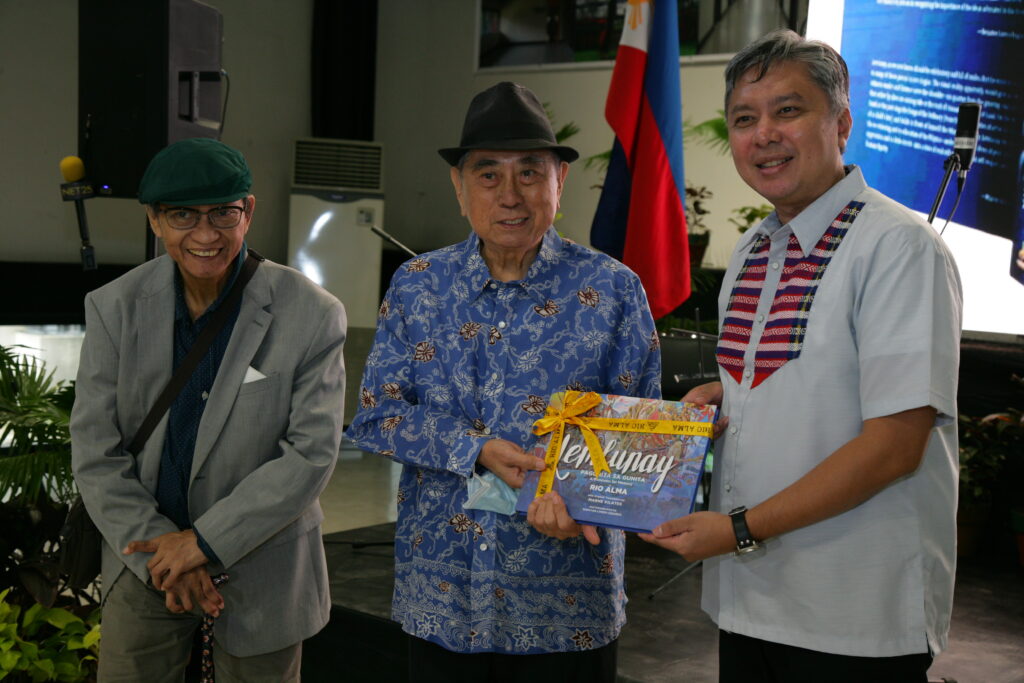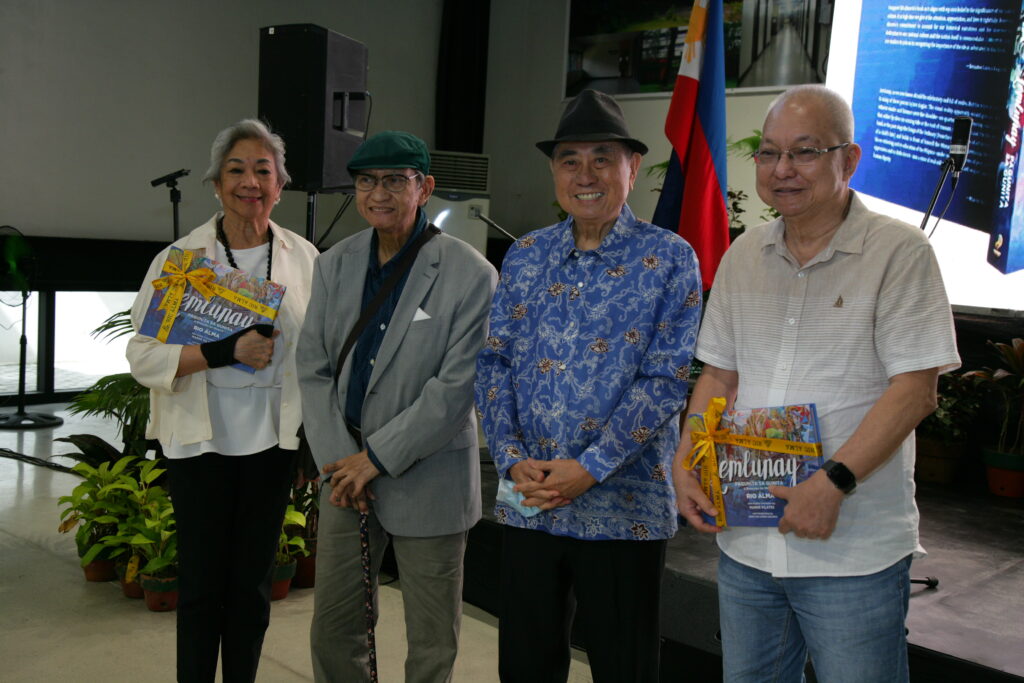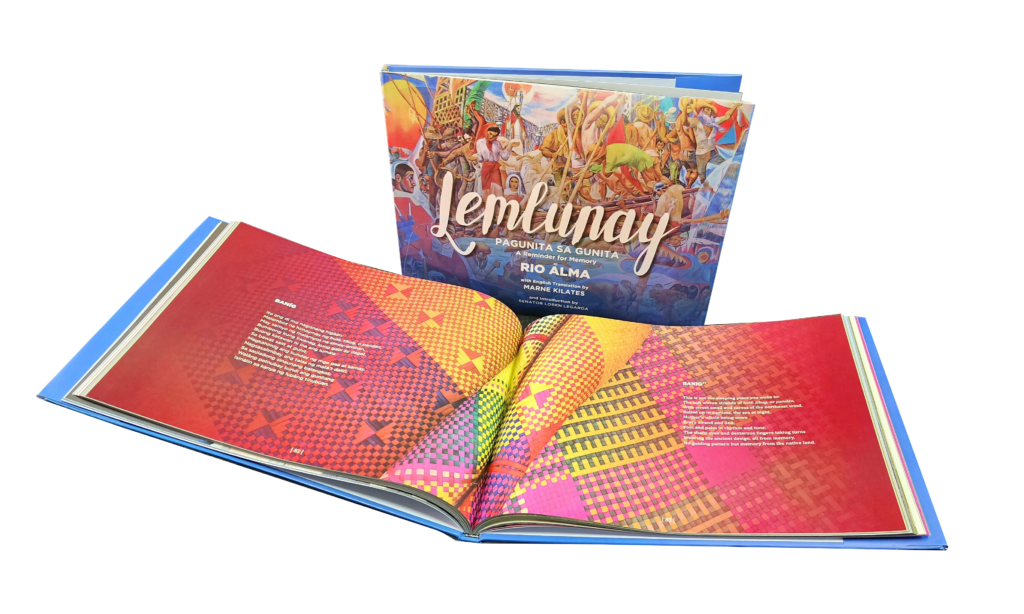Poet Virgilio S. Almario is currently the most prolific among country’s National Artists, publishing an average of one to two books a year. This year has been more bountiful than usual with the launch of four books!
Mga Póon, Mga Piyón, Mga Pusóng, Isang Púsong, a collection of poetry published in 2022 by San Anselmo Publications, Inc., was launched on 12 March, on his birthday. It has become a tradition that the former chairman of Komisyon sa Wikang Filipino and National Commission for Culture and the Arts launches a book on his birthday.
Two more books followed — Ang Wikang Pambansa at Amerikanisasyon: Isang Kasaysayan ng Pakikihamok ng Filipino para Maging Wikang Pambansa, published by Ateneo de Manila University Press and launched on 18 August, and the third edition of Si Balagtas at ang Panitikan Para sa Kalayaan, published by University of Santo Tomas Publishing House and launched on 2 October.
Capping the fruitful year was the launch of Lemlúnay: Pagunita sa Gunita (Lemlúnay: A Reminder for Memory) on 2 December at the Ignacio B. Gimenez Gallery in University of the Philippines in Diliman, Quezon City, aptly a literary celebration attended by esteemed writers, artists, historians, academicians and cultural workers including Marvin Aceron, Celeste Lecaroz, John Iremil Teodoro, Xiao Chua, Karl Orit, Michael M. Coroza, Egai Talusan Fernandez, Noel Ferrer, Grace Banez, Ruth Elynia Mabanglo, Fe Mangahas, Maria Karina Africa Bolasco, Banaue Miclat, Fidel Rillo, Edgar Calabia Samar, Vim Nadera, Segundo Matias, Alma Cruz Miclat, Enrico John Torralba and Roland Tolentino.
Almario was joined by fellow National Artists — National Artist for dance Alice Reyes, National Artist for film and broadcast arts Ricky Lee and National Artist for music Ramon Santos — as well as UP Chancellor Edgardo Carlo L. Vistan II.


The presence of former Vice President Leni Robredo excited attendees.
“A highlight for Beng and me was the presence of VP Leni Robredo, who very graciously allowed us these selfies. (There are very few people I fan-boy over; Leni is one of them),” wrote writer and professor Jose “Butch” Dalisay on his Facebook account.
In an unprecedented move, the Philippine culture and the arts sector, led by most of the living National Artists, expressed support and significantly contributed their time and talents to the campaign when Robredo ran for the presidency in 2022. They have forged a lasting friendship.
The launch program, organized by the NCCA, Office of Senate President Pro Tempore Loren Legarda, Filipinas Institute of Translation and Linangan sa Imahen, Retorika, at Anyo, featured poetry readings by Almario himself, Ralph Fonte, Toni Panagu and Marayzaya Sodbileg, and a song inspired by the poem “Lemlúnay,” composed by Jai Saldajeno and performed by Karl Arnold Saret with guitarist Daniel Joseph Morabe.
Published by NCCA and using his pseudonym Rio Alma, Lemlúnay: Pagunita sa Gunita featured 30 of Almario’s poems written in Filipino in the last six years, from 2018 to 2023, accompanied by excellent English translations by poet Marne Kilates, who wrote his thoughts on translating the work as well as the significance of the poems. I was honored to have my photographs featured in the hardbound book, which I also designed together with Mervin Concepcion Vergara. It was edited by Eilene Antoinette G. Narvaez, who also oversaw the production with NCCA’s Elle Danganan.
There are additional ways of seeing in this book. One is through the translator’s interpretations and another is through the photographer’s and designers’ visual renditions, aside from the intrinsic meanings of the subjects.

The title of the book is a term that denotes the concept of paradise in the mythology of the T’boli people of southern Philippines, signifying the aspiration or dream of a better country through a deeper and critical reflection on our history and culture and interactions with cultural products.
In his speech, Almario provided the context in which the book was written, saying that it — along with his most recent books, Ang Wikang Pambansa at Amerikanisasyon: Isang Kasaysayan ng Pakikihamok ng Filipino para Maging Wikang Pambansa, Si Balagtas at ang Panitikan Para sa Kalayaan, and Sapantahàng Wika (University of Santo Tomas Publishing House, 2022) — is a product of his search for new methods and ways of writing poetry and seeing our history and culture that is more Filipino and divested of colonial influences
“At ang lahat ng ito ay recent na produkto ng aking mga pag-iisip. Kasabay nito ang Lemlúnay. Bumubuo ako ngayong ng isang panitikan para sa aking sarili na nagsasama-sama ang aking sariling pagtula at aking critical mind para mabuo ang isang bagong matatawag kong sapantahà tungkol sa ating panitikan, isang bagong paraan ng pagtingin sa ating panitikan na matatawag nating higit na autentiko, Filipino at hindi masyadong nalalaganapan ng kolonyalismo at Amerikanisasyon (All of these are recent products of my ponderings, including Lemlúnay. I am now creating a literature for myself, which will combine my own poetry, my critical mind to form a new what I call theory about our literature, a new way of seeing our literature that is more authentic, Filipino and not much influenced by colonialism and Americanization),” he said.
“Ang Lemlúnay ay isang paggunita sa ating kasaysayan. Ang naiba rito sa librong ito ay ginawa ko ang pagmumuni tungkol sa kasaysayan ng Filipinas sa pamamagitan ng mga cultural objects magmula sa primitive art objects, mga relics, at mga natuklasan recently na mga fossils at iba pa, gayun din ang mga likha ng ating mga dakilang pinto, manunulat na kailangan nating balikan, pag-aralang mabuti at ituwid ang ating paningin tungkol dito (Lemlúnay is a remembrance of our history. The difference of this book is that I reflected on the history of the Philippines through cultural objects, from primitive art objects, relics and recently discovered fossils and others, as well as works by our great painters and writers, which we must return to, study diligently and correct our perception about them),” he concluded.
Kilates, in his “Translator’s Note,” considers Lemlúnay as “a new landmark work.”
“In it he is the Rio Alma that lures us with the sparkle and grit of his poetic language and grips us with his penetrating insights and never lets go of our questioning mind,” he wrote.
He explains: “Lemlúnay, as we now know, should be celebratory and full of smiles. But the voice or voices in many of these poems is/are elegiac. The visual reality apparently would give us — eye-witness reader and listener-over-the-shoulder — no quarter from the growing realization that, either by slow on-coming tide or the rush of tsunami, sorrow is at hand. On the other hand, as the poet sings the Songs of the Ordinary (from the contemplation of art to the flying of a child’s kite) and holds in front of himself the Mirror of History, Lemlúnay demands the re-visioning and re-education of the Filipino — under centuries of dross of post-colonial oppression and no little deceit — into a state of real self-pride, national self-respect and true human dignity.”
